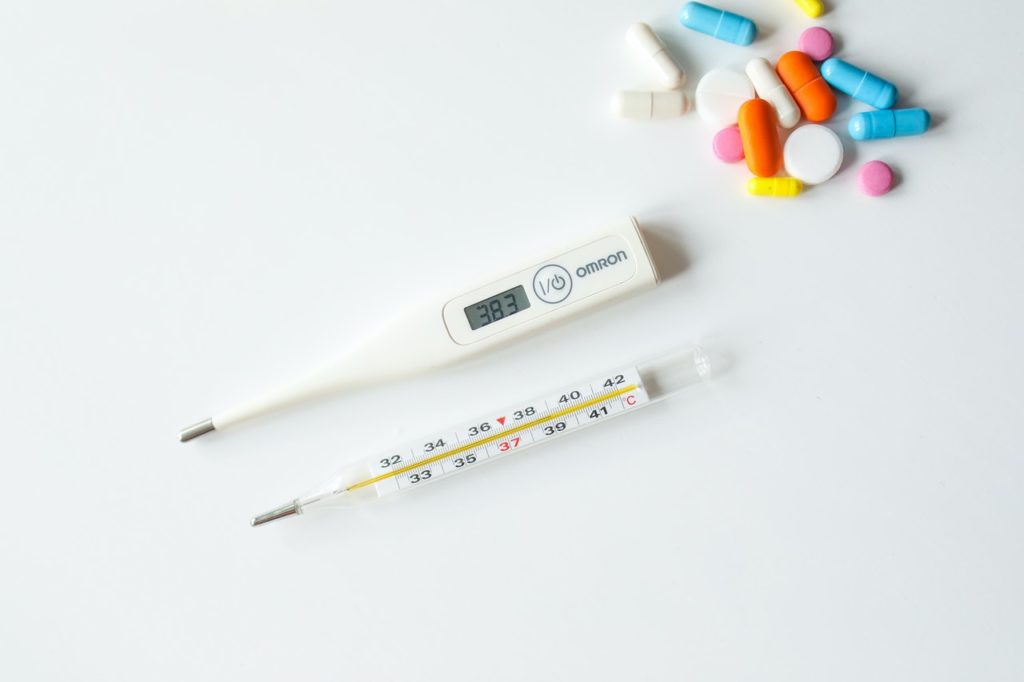
I learned this today. The body produces a fever because pyrogens cause the hypothalamus to raise its set-point for body temperature.
Fever is a defense mechanism, and most fevers happen when your body has a bacterial, viral or parasitic infection. Other things, such as alcohol withdrawal and heat stroke, can also cause a fever.
Raising the body’s temperature has a metabolic cost. It requires energy and we are going to have to replace that energy. This must mean that there is more benefit to having a fever than not having one. All mammals can develop a fever, which shows that it is beneficial. Fish and lizards, who cannot produce a fever, seek out warmth to raise their body temperature when they have an infection.
So, before we look at how we get a fever let’s look at why.
If you have a viral infection, such as influenza, the virus thrives best at normal body temperature. When the temperature of the body is increased, it makes it inhospitable for the virus. Your body is trying to cook the virus. However, this is not the only beneficial reason for a fever.
When you fight an infection, you need to use T-cells, which are a type of white blood cells. These T-cells float around in the blood until they detect a virus. There are two types of T-cells, helper T-cells and killer T-cells. When the killer T-cells detect a virus, they do what their name says and attack it. Meanwhile, the helper T-cells head to the closest lymph node where they stimulate the production of B-cells, which carry antibodies, and of more killer T-cells.
What does this have to do with fever? The T-cells have to get from the blood stream to the lymph node and the blood in our bodies moves pretty quickly. When we have a fever, the increasing heat stimulates T-cells to produce two proteins. These are alpha-4 integrin and heat shock protein 90 (Hsp90). As the body temperature rises, the T-cell produces more Hsp90. When the Hsp90 molecules have accumulated, they switch the alpha-4 integrin proteins to an active state. That makes them sticky and stick out. They look like the hooks on Velcro. Using these, the T-cell can grab onto the blood vessel near to a lymph mode and squeeze through.
To test this, experimenters altered some mice so that the Hsp90 couldn’t activate the alpha-4 integrin. Almost no T-cells reached the lymph nodes for those mice. So, without a fever, our body wouldn’t be able to begin mounting a defense against invaders.
So. how does our body give us a fever?
It does it by resetting the hypothalamus. The hypothalamus is at the base of the brain, and it is it responsible for hunger, thirst, attachment behaviors, fatigue, sleep, circadian rhythms, and body temperature. The hypothalamus has two choices when it comes to body temperature: too hot or too cold. If the body is too hot, the hypothalamus will trigger sweating to cool us down, and if it is too cold, the hypothalamus will trigger shivering and other responses to warm us up.
When a virus or a bacteria enters our body, they release pyrogens. These pyrogens travel through the blood to the brain where the brain produces prostaglandin E2 (PGE2). This PGE2 interacts with the hypothalamus and the hypothalamus adjusts its body temperature set-point upwards by a couple of degrees.
Once the hypothalamus has a new set-point, a number of physiological changes start to happen to warm the body up to that new set-point.
The blood vessels constrict, reducing heat loss through the skin. Norepinephrine is released by the adrenal gland to burn brown adipose tissue to generate heat. The body’s metabolic rate rises and blood is moved away from the extremities to the warmer core. The muscles start to contract to burn energy, which is shivering.
The fever continues until the virus or bacteria has been dealt with. The bacteria or virus will continue to produce pyrogens until they are no longer in the body and the pyrogens will cause the brain to keep making PGE2, which keeps the hypothalamus’ set-point high. Once the pyrogens are gone and the PGE2 production stops, the temperature set-point returns to normal.
Photo by Polina Tankilevitch from Pexels
Sources
https://www.medicalnewstoday.com/articles/321889#The-protein-that-alters-temperature-reactivity
https://www.everydayhealth.com/cold-and-flu/why-do-we-get-chills-with-a-fever/
https://www.science.org/content/article/dont-fight-fever
https://en.wikipedia.org/wiki/Fever
https://www.ncbi.nlm.nih.gov/pmc/articles/PMC4786079/
https://www.livescience.com/32134-what-causes-a-fever.html
https://www.scientificamerican.com/article/what-causes-a-fever/
https://en.wikipedia.org/wiki/Lymph_node
https://www.cancercenter.com/what-are-b-cells-vs-t-cells
https://en.wikipedia.org/wiki/Hypothalamus
https://www.onio.com/article/what-does-the-brain-go-through-during-a-fever.html
